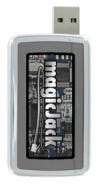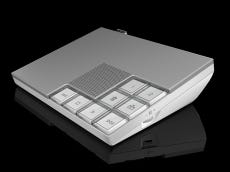Review: Two VoIP Products Offer Long Distance For Free
MagicJack and ooma combine VoIP with your existing home phone service to provide you with free long-distance calls.

"Rent vs. buy" is a classic business dilemma. Is it cheaper to rent office space or buy a building? Buy copy machines, or lease them? Now there's a new one to add to the list: rather than pay for telephone service by the month, why not buy a little hardware that delivers free phone service for a year or more at a time?
New products from YMAX Communications Corp. and ooma, Inc., do just that -- they let you continue to use your existing telephones, but pay a one-time fee for some digital hardware that uses (VoIP).
Both deliver free local and long-distance calling in the United States and Canada. The difference is that the YMAX MagicJack is cheap and dead easy to use, but limited in its features. The ooma Hub is more expensive and more complicated, but offers more features.
Removing The Nerd Factor From VoIP
Because VoIP works wherever the Internet works, it is driving the cost of phone service (and especially long-distance calling) toward zero, and sprouting new services like visual voicemail. But its success depends on impersonating everything that's familiar about telephone service -- it has to work the way we're used to using telephones, dialtone, trimline handsets, and all.
The two pioneers of VoIP, Vonage and Skype, took differing approaches. Vonage adopted the existing POTS business model hook, line and sinker: You pay for special equipment, and you pay by the month for service. Skype took a different approach: It left the equipment up to you, and charged for service on a minute-by-minute and feature-by-feature basis. Both have had success, but each points up a weakness of the other's approach: Skype makes Vonage look more expensive than VoIP has to be, while Vonage makes Skype's headset-and-microphone approach look nerdy and off-putting.
Both the MagicJack and the ooma Hub are focused on doing a better POTS imitation -- cutting the price of service while reducing the nerdiness of VoIP.
The Very Mobile MagicJack
The YMAX MagicJack does this with elegant simplicity. The MagicJack hardware is a pillbox-sized device with a USB connector on one end and an RJ-11 phone jack on the other. Plug in a phone and connect it to your PC (USB 2.0 required, and Windows only for the present -- a Mac version is on the way) and the device does the rest -- it installs the required software and a control panel that lets you manage a contact list, voicemails, and account details.
|
You can dial a number from either the phone or the onscreen display, or you can use a headset and microphone attached to the PC.
When you register your MagicJack, you pick a phone number that is permanently assigned to your device for inbound calls -- something Skype charges extra for. The combination of an inbound number and headset support makes the MagicJack a very portable telephone. You can receive calls wherever you can connect your laptop to the Internet, or you can even do without the laptop, and carry the MagicJack and an inexpensive portable earpiece/microphone.
The MagicJack comes with voicemail service, so that even when you can't get your device online, you can call your MagicJack number from any phone to check messages.
The MagicJack costs $39.95, a price that includes the hardware device and a year of unlimited long-distance calling in the United States and Canada; you can buy an additional year of service for $19.95. For that you get unlimited voicemail, call waiting, and three-way calling. (The Web site also mentions a "Follow Me" service to forward calls sent to your MagicJack number to other numbers as well, but I couldn't find it in the control panel.)
There's quite a bit you don't get with MagicJack. While you can now order a MagicJack, the Web site still says "Beta 4.0" and YMAX seems to have pushed its device out into the marketplace just a little bit before it was fully baked. You have a limited selection of area codes for your MagicJack number, for one thing, and during the beta period the MagicJack doesn't support international calling. The Web site indicates both deficiencies will be corrected within the next several weeks, and says it will be possible to switch your number and set up a prepaid account for international calling.
While you can't yet dial phones in foreign countries, a MagicJack device will work overseas, so if you travel overseas (or send a MagicJack to an overseas relative) you can probably exchange calls with U. S. numbers.
In use, the MagicJack just works. YMAX provides an ad-supported 411 service, and you can register your current location for 911 support (which, YMAX says, is "different than 911 service offered on traditional phone lines"). The MagicJack's audio quality is at least as good as competing VoIP services (which means that it's more dependent on the input device than on the service itself -- the voicemails I left for myself seemed to have better voice quality when I used a standard telephone rather than an inexpensive USB headset/microphone, for example).
Overall, for ease of use and low price for an inbound number, the MagicJack seems hard to beat.
The Sophisticated ooma Hub
The ooma Hub also lets you use your regular phone to make VoIP calls. In many ways, it's a considerably more ambitious device than the MagicJack -- and at $399, it's also considerably more expensive.
|
For that money, you get a stylish device that works as a digital answering machine and gives you free local and long-distance calling in the United States for "at least three years" (more on that qualifier later) and has an assigned telephone number for inbound calls. The ooma Hub can work just like the MagicJack to give you VoIP phone service independent of your existing landline service. Or (with a little more hardware) it can integrate your landline and all your extension phones so that you can keep using your current phone number for inbound calls and features like 911 service, but make VoIP calls from any phone.
Either way, the ooma Hub connects to your phone, your broadband modem or DSL connection, and your wireless router, if you have one. This configuration is recommended, says the ooma installation guide, because the device delivers the best audio quality if it can prioritize its own traffic to the Internet ahead of other IP data on your home network.
In practice, while the audio quality was good, it wasn't markedly better than other services. And I found that connecting the ooma Hub behind a router worked just fine. It requires a cabled Ethernet connection, though, and that may create some awkwardness if your router isn't close to where you want to use the answering-machine functions of the Hub.
If you want to use the ooma Hub simply as a stand-alone VoIP connection, you're all set. If you want to integrate your existing landline you have to connect the Hub to the landline and install a $39 device called a Scout on each phone extension you want to bring into the ooma system (and disconnect any extensions you don't want to convert -- you can't use both VoIP-enabled phones and regular phones on the same landline system).
This integration also means that ooma will reprovision your landline service. Most services, like caller ID and 911, will be unaffected, but some, like voicemail and call forward, will be changed, and your bill from your landline company may be affected.
If you integrate your landline service with ooma and install at least one Scout unit, you can use an "Instant Second Line" feature. (You can review voicemail from any Scout unit on the system, as well.) Other ooma features include call-waiting, three-way conferencing, a "Do not disturb" function, and a local answering machine. You can also check messages remotely by dialing the Hub's number (or your landline number if you've integrated the two), or on the Web by logging into your account on the ooma Web site.)
You can use your ooma system to make international calls if you prepay for calling minutes through your ooma account online -- the available countries and rates are listed on the site, and seem comparable to similar services from other providers.
Your investment in the ooma Hub gets you free local and long-distance calling in the United States -- the ooma Web site says "for at least three years." In an FAQ it explains that the three-year period is an estimate of the Hub's service life and implies customers will receive free service as long as their Hub device is functional. Given the current life expectancy of similar digital devices from iPods to PCs, "three years" is probably reasonable.
The complexity of the ooma configuration has a few drawbacks -- a fax machine should be connected directly to the Hub rather than a Scout, for example, and if you have other telephone connected equipment you should make sure it will work. But there are some advantages, too: Integrating ooma with landline service means that you can get the benefits of VoIP and still have phone service if your Internet provider goes down.
About the Author(s)
You May Also Like
How to Amplify DevOps with DevSecOps
May 22, 2024Generative AI: Use Cases and Risks in 2024
May 29, 2024Smart Service Management
June 4, 2024








